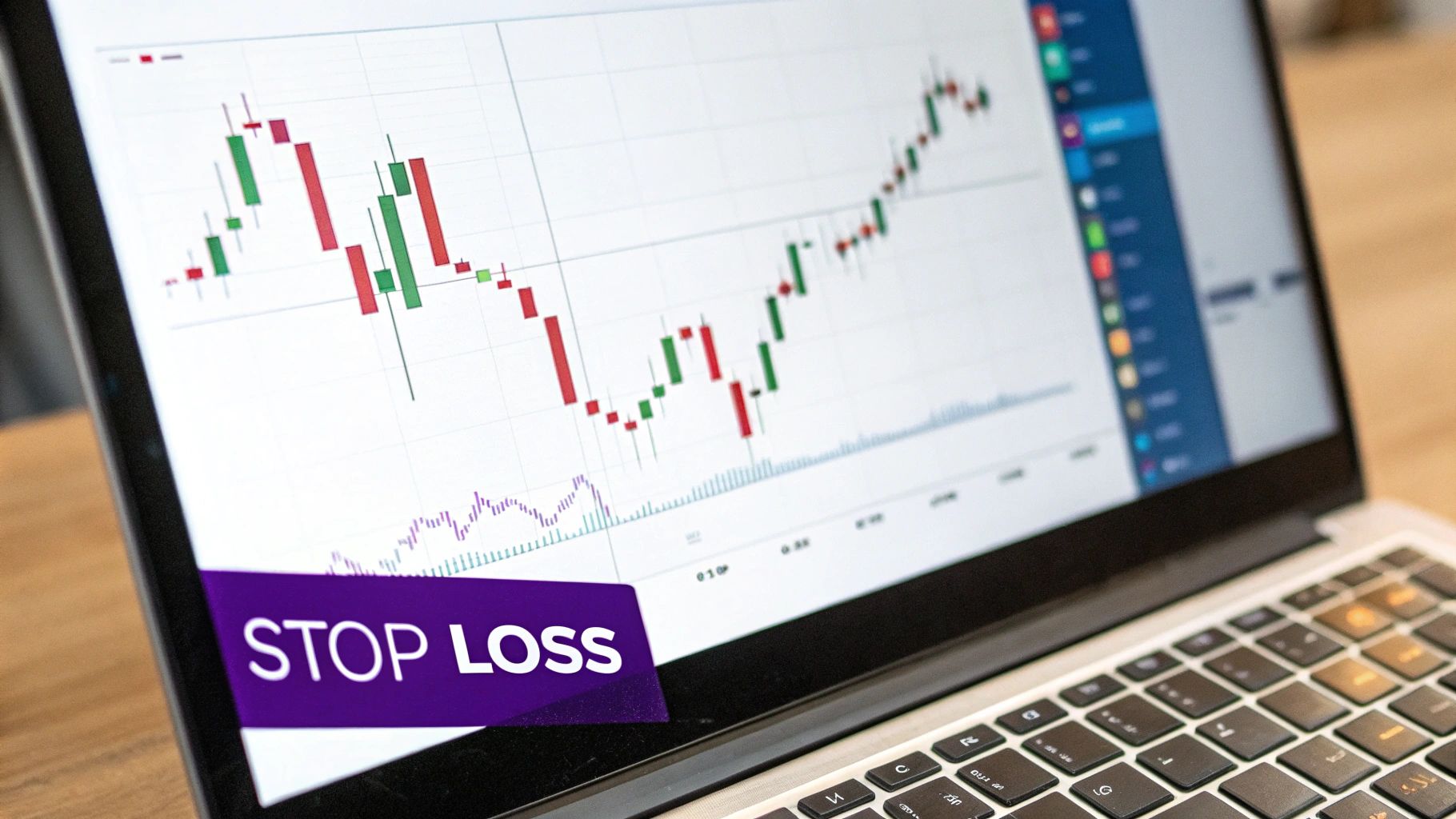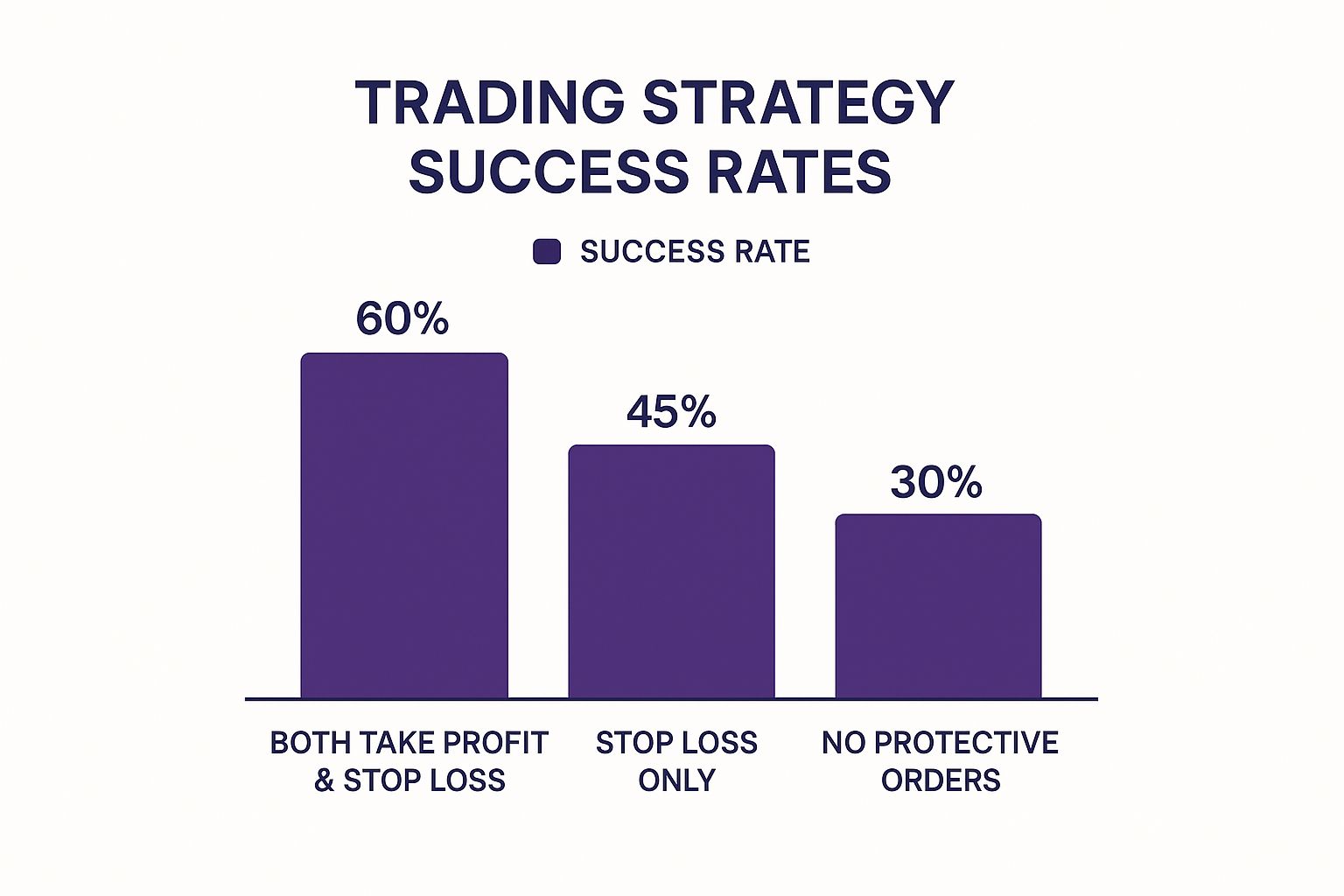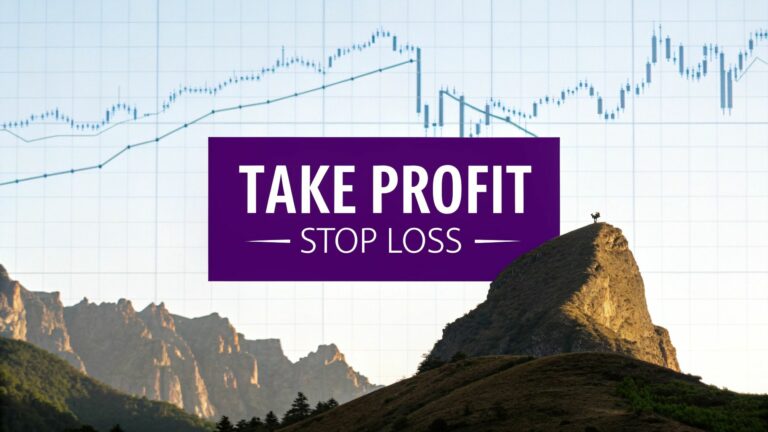Think of a take profit order as your designated finish line—the exact price where you decide to automatically sell and lock in your gains. On the flip side, a stop loss order is your safety net, automatically selling your position to cut a loss before it gets out of hand.
The Trader’s Ultimate Toolkit for Risk Management
Every smart trader knows that a good plan isn't just about winning; it's also about knowing when to walk away. Think of yourself as a mountain climber mapping out a route. You have a clear summit in mind, but you also have a non-negotiable safety point you won’t go below. In trading, take profit and stop loss orders are those critical points on your map.
These automated orders are the bedrock of disciplined trading because they take raw emotion out of the equation. A take profit order ensures you actually bank your winnings by closing your trade when it hits a target price. A stop loss is your insurance policy, preventing a minor setback from turning into a major financial hit. This strategic approach is what separates pros from amateurs who are just hoping for the best.
Take Profit vs Stop Loss at a Glance
To really get a feel for how these tools work, it’s helpful to see them side-by-side. Each one serves a unique purpose, is triggered by different market moves, and gives you a distinct psychological edge. This table breaks down their core functions before we dive deeper.
| Feature | Take Profit Order | Stop Loss Order |
|---|---|---|
| Primary Purpose | To automatically lock in profits when a price target is met. | To automatically limit losses when the price moves against you. |
| Market Condition | Triggers when the market price moves in your favor to a set level. | Triggers when the market price moves against you to a set level. |
| Psychological Benefit | Combats greed by enforcing a predefined exit for gains. | Controls fear by establishing a maximum acceptable loss. |
Ultimately, mastering these tools means building a solid framework for every single trade. It’s all about deciding your exit points—for both wins and losses—while you’re thinking clearly, not when the market is going wild. If you're just starting out, the vTrader Academy offers fantastic foundational courses to build your skills and confidence. You can check them out at https://www.vtrader.io/en-us/academy.
For a broader view on how risk management works elsewhere, understanding different trading instruments like spread betting can be quite insightful, as they also lean heavily on disciplined exit strategies.
How Stop Loss Orders Protect Your Capital

Think of a stop loss order as your essential safety net for every single trade. It's the line in the sand you draw before you enter the market—the exact point where you'll accept a small, calculated loss to dodge a devastating one.
But its real power isn't just about limiting financial damage. It’s about taking your biggest trading liability out of the game: your emotions.
When a trade sours, it's human nature to hope for a miraculous turnaround. This hope is a trader's kryptonite, often leading them to cling to losing positions as their capital bleeds out. A stop loss is a pre-emptive strike against this tendency. It’s a logical decision made with a clear head, automatically executing to save you from yourself when the market gets heated.
Smart Ways To Set Your Stop Loss
Placing a stop loss isn't a guessing game. A strategically placed stop is grounded in market behavior and your own personal risk appetite. Let’s break down some of the most effective ways to set this crucial order.
1. The Support Level Method
This is a classic technique straight from the technical analyst's playbook. A support level is a price floor where an asset has historically found enough buyers to bounce back.
Setting your stop loss just beneath a major support zone is a logical move. Why? Because if the price breaks through that floor, it often signals that a much bigger drop is coming. On the vTrader platform, for instance, you can draw these support lines right on your chart, giving you a clear, data-backed spot for your exit.
2. The Fixed Percentage Method
This approach is all about consistency and discipline. You simply decide the maximum percentage of your total trading capital you’re willing to lose on any single trade—typically between 1% to 3%—and place your stop there.
If you have a $10,000 account and stick to a 2% rule, your maximum loss on any trade is capped at $200. This straightforward calculation removes emotion from risk management and ensures that no single bad trade can cripple your portfolio.
3. The Moving Average Method
For traders who ride trends, a moving average can serve as a dynamic, moving support level. Since a moving average smooths out price action to show the underlying trend, it’s a great indicator for an exit point.
A popular strategy is to set a stop loss just below a key moving average, like the 50-day or 200-day. If the price slices through that line, it’s a strong sign the trend is losing steam or reversing entirely.
Key Takeaway: A stop loss isn't about avoiding losses—that’s impossible in trading. It's about ensuring your losses are small, controlled, and part of a winning long-term strategy.
Protecting Profits With a Trailing Stop
While a standard stop loss is fixed, a trailing stop is beautifully dynamic. It’s a stop order that follows your profitable trade upward but freezes the moment the price turns down. This incredible tool lets you lock in gains while giving your winning trade more room to run.
Imagine you buy a crypto at $100 and set a 10% trailing stop. Your initial exit is at $90. As the price climbs to $120, your trailing stop automatically adjusts upward to $108 (10% below $120), locking in an $8 profit per share. If the price then dips to $108, your trade closes automatically, securing your profits before they vanish.
This method shines in strong, trending markets where you want to ride the momentum for as long as possible without giving back all your hard-earned gains. It’s no wonder these tools are a cornerstone of professional trading; in fact, roughly 88% of day traders rely on stop-loss orders to automate their risk management.
Just as we’re committed to protecting your data, which you can read about in our privacy policy, you must be equally committed to protecting your capital.
Using Take Profit Orders to Secure Your Gains

While a stop loss is your shield against major losses, a take profit order is your sword for securing wins. Think of it as an automated instruction that closes your trade once the price hits a profit level you've already decided on. This simple tool ensures you actually walk away with the money you've made.
Winning a trade feels great, but the real test is pocketing those gains. Greed can be just as destructive as fear, tempting you to cling to a winning position for "just a little more," only to watch the market reverse and wipe out your progress. A take profit order is your defense against that emotional trap.
By setting your target ahead of time, you're trading with a clear, disciplined exit plan. It’s the difference between wishful thinking and executing a well-thought-out strategy.
Identifying Your Profit Target
Placing a take profit order isn't just about pulling a number out of thin air; it’s a calculated move based on what the market is telling you. A solid target is both ambitious enough to be worthwhile and realistic enough to be hit. Here are a few battle-tested methods traders use to find the sweet spot.
- Resistance Levels: Just as support levels act as a floor, resistance levels act as a ceiling where selling pressure has historically stopped a rally in its tracks. Placing your take profit order just below a known resistance zone is a classic and highly effective strategy.
- Fibonacci Extensions: For traders who want to get a bit more technical, Fibonacci extensions are a fantastic tool. These levels project potential price targets beyond the current trend, helping you spot logical places where a price move might finally lose its steam.
- Risk-to-Reward Ratio: This is a core principle of disciplined trading. If you set your stop loss to risk $50 on a trade, you might aim for a $100 or $150 profit, giving you a 1:2 or 1:3 ratio. This simple math ensures your wins have a much bigger impact than your losses over time.
Key Insight: A take profit order doesn't limit your potential; it guarantees a successful outcome. It’s the mechanism that turns paper profits into real, spendable gains in your account.
How Take Profit Orders Work in The Real World
The real power of a take profit order comes from its automation. It works for you even when you're offline, preventing you from second-guessing your strategy when prices get volatile.
A perfect example of this unfolded with United States Steel Corporation (X). On December 15, 2023, the stock shot up over 25% following news of a massive $14.9 billion acquisition deal. A smart trader, knowing that this kind of explosive move would eventually hit a wall, identified a potential resistance area around the $52 mark.
They placed a take profit order right at that level. Sure enough, a few days later, the stock surged, touched $52, and the order executed instantly. That single, pre-set action locked in a profit of over $13 per share without the trader having to lift a finger. You can get more details on this trade from The Trading Analyst.
This case study shows just how powerful a clear exit strategy can be. The trader defined their win, set the order, and let the plan do the work, capturing the peak profit right before the momentum faded. It’s a textbook illustration of how a take profit and stop loss framework creates a complete trading plan from start to finish.
On platforms like vTrader, setting these orders is a seamless part of the process. You can see your entry point, stop loss, and take profit levels right on the chart, giving you a full picture of your risk and reward before you ever commit capital. It’s this kind of integrated approach that builds the discipline required for long-term success.
Calculating Your Risk to Reward Ratio

Once you've decided where you'll exit a trade for both a win and a loss, it's time to tie them together with a powerful tool: the risk-to-reward ratio. This isn't just a bit of trader jargon; it's the core logic that transforms your take profit and stop loss levels from two separate ideas into a single, cohesive strategy.
At its heart, the risk-to-reward ratio is a simple question: "How much am I willing to risk for a certain amount of potential profit?" Answering this honestly and mathematically is what separates disciplined traders from gamblers.
The Simple Math Behind Smart Trading
To figure out your ratio, you just need to divide your potential profit by your potential loss. Your potential profit is the distance between your entry price and your take profit target. Your potential loss is the gap between your entry and your stop loss.
The formula looks like this:
Risk-to-Reward Ratio = (Take Profit Price – Entry Price) / (Entry Price – Stop Loss Price)
Let's walk through a real-world example. Imagine you’re eyeing a crypto asset trading at $100. After doing your homework, you set a take profit order at $120 and place a stop loss at $95.
- Potential Profit: $120 (Take Profit) – $100 (Entry) = $20
- Potential Risk: $100 (Entry) – $95 (Stop Loss) = $5
- Ratio: $20 / $5 = 4. This gives you a 1:4 risk-to-reward ratio.
In plain English, you're risking $1 for the chance to make $4. This is exactly the kind of asymmetric bet that professionals hunt for, where the potential upside massively outweighs the downside.
Crucial Insight: A strong risk-to-reward ratio gives you a mathematical edge. It means you don't have to be right all the time to be profitable, creating a crucial buffer against the market's inherent unpredictability.
Why a Healthy Ratio is Non-Negotiable
Most seasoned traders won't even consider a trade unless the risk-to-reward ratio is at least 1:2. That means your potential gain must be at least double your potential loss. The reason is pure statistics.
Let's look at how this plays out for different traders:
| Trader | Risk/Reward Ratio | Required Win Rate to Break Even |
|---|---|---|
| Trader A | 1:1 (Risks $100 to make $100) | 50% |
| Trader B | 1:2 (Risks $100 to make $200) | 33.3% |
| Trader C | 1:3 (Risks $100 to make $300) | 25% |
See the difference? Trader B can be wrong almost 70% of the time and still not lose money. That mathematical cushion is what builds resilient, long-term trading strategies. It removes the immense pressure of needing a perfect track record.
On the vTrader platform, you can visually set your take profit and stop loss orders right on the chart, and the tool often shows your risk-to-reward ratio automatically. This makes it incredibly easy to ensure every single trade lines up with your risk management rules. And since vTrader is a commission-free exchange, your calculations aren't chipped away by fees. You can get the full breakdown of our zero-fee structure on the official vTrader's fee schedule. This level of clarity is vital for accurately applying these risk principles.
Practical Strategies for Setting Order Levels
Knowing the theory behind take profit and stop loss orders is one thing, but putting it into practice is where real confidence is built. It’s time to move past the textbook and into actionable, repeatable strategies for placing your orders with purpose. These aren’t just random guesses; they're methods grounded in market data and structure, giving you a solid reason for every trade you make.
Let's break down three of the most effective techniques traders use to pinpoint their exit levels. Each offers a unique angle, making them suitable for different trading styles and market conditions. Think of this as building a versatile toolkit you can pull from no matter what the market throws at you.
The Percentage Method
Sometimes, the simplest approach is the most powerful. The percentage method is a clean, rules-based strategy where you set your take profit and stop loss at a fixed percentage away from your entry price. This is a fantastic way to enforce strict risk discipline.
For instance, you might decide to always place your stop loss 2% below your entry and your take profit 4% above it. This automatically locks in a consistent 1:2 risk-to-reward ratio on every single trade, protecting your account from any one devastating loss. By removing subjective emotion from the equation, it’s an ideal starting point for new traders or anyone who thrives on a mechanical system.
The Support and Resistance Method
This technique is a true cornerstone of technical analysis. It all comes down to identifying key price levels on a chart where the market has historically hit a wall and reversed. A support level acts as a price floor where buyers tend to jump in, while a resistance level is a ceiling where sellers usually take over.
When using this method, you’d place your stop loss just beneath a solid support level and your take profit order just under a clear resistance level. The logic here is simple but sound: if a price breaks below its support floor, it often signals a much deeper slide is coming. This strategy, which is easy to spot on vTrader charts, helps align your trades with the market's natural psychological barriers.
The data below shows just how much protective orders can swing the odds in your favor.

This visual drives the point home: traders using both take profit and stop loss orders see dramatically better success rates than those using just one—or none at all.
The Moving Average Method
If you're a trader who prefers to ride the wave of a trend, moving averages provide a dynamic way to set your exit points. A moving average (MA) smooths out choppy price action into a single, flowing line that helps reveal the underlying trend direction. That line often becomes a mobile support or resistance level.
A popular strategy is to set a stop loss just below a key moving average, like the 50-day MA, during a strong uptrend. If the price closes below that line, it’s a powerful signal that the trend might be losing steam or even reversing. This approach helps you stay in a winning trade as long as the trend holds up and gets you out the moment it shows signs of faltering.
Choosing the right approach often boils down to your trading personality and the current market environment. Our team is constantly discussing these strategies and how they apply to today's market events. To see how we analyze market movements, check out the latest updates on the vTrader news hub.
To help you decide which strategy might work best for you, here’s a quick comparison.
Comparison of Order Setting Strategies
| Strategy | Core Logic | Best For |
|---|---|---|
| Percentage Method | Manages risk with fixed, predefined percentages from the entry price. | Beginners, systematic traders, and those seeking strict consistency. |
| Support & Resistance | Uses historical price barriers as logical exit points. | Technical analysts and traders who focus on chart patterns. |
| Moving Average Method | Follows the market trend using a dynamic indicator as a guide. | Trend followers and traders who prefer a "set it and follow" approach. |
By getting comfortable with these techniques, you're not just learning a trick; you're equipping yourself with the tools to build a complete trading plan for any scenario.
Common Questions About Trading Orders
Even when you feel you've got a handle on how a take profit and stop loss works, theory and practice are two different things. Once you're in a live market, questions always pop up. This section is your go-to reference for tackling the most common—and critical—questions that traders face.
Think of it as a way to firm up what you've learned so you can step into the real world of trading with more confidence. We’ll get straight to the point with actionable answers to help you navigate those tricky situations and make smarter choices with your orders.
Should I Adjust My Orders After Placing Them?
This is one of the most tempting and dangerous things a trader can do. As a general rule, you should avoid widening your stop loss after a trade is live. Remember, you set that stop loss when you were calm and objective, defining the maximum risk you were willing to take. Moving it further away is almost always an emotional reaction—a desperate hope that a losing trade will magically turn around. That’s a recipe for disaster.
However, moving a stop loss in your favor is a completely different story. It’s a smart and widely used tactic. Once a trade is nicely in profit, adjusting your stop to your entry price (breakeven) takes all the risk off the table. You can also trail it behind the price as it moves up, locking in your gains along the way.
Messing with your take profit order is a bit more of a gray area. If new market information genuinely points to a higher potential target, it might be justifiable. But more often than not, it's just greed creeping in. The best traders stick to their original plan.
Expert Insight: Successful traders treat their initial trade plan like a contract with themselves. A stop loss is only ever moved to reduce risk, never to increase it.
What Is a Trailing Stop and How Is It Different?
A standard stop loss is static—it’s a fixed price. A trailing stop, on the other hand, is dynamic. It’s a smarter kind of stop loss that automatically follows a rising price, letting you ride a trend while still protecting your profits.
Instead of picking a specific price level, you set a trailing stop at a certain percentage or dollar amount below the current market price.
Let’s walk through a quick example:
- You buy a coin at $50 and set a 10% trailing stop. Your initial stop loss is now at $45.
- The price rallies to $60. Your trailing stop automatically moves up with it to $54 (10% below $60), locking in a $4 profit per coin.
- The price keeps climbing to $70. Your stop loss follows, now sitting at $63 and securing a $13 profit.
- If the coin’s price then drops and hits $63, your sell order is triggered, and you exit the trade with your secured gains.
The key here is that a trailing stop only moves up—it never moves down. It’s a fantastic tool for getting the most out of strong trends without having to sit there and manually adjust your exit point every five minutes.
Can My Order Execute at a Different Price?
Yes, absolutely. This is a phenomenon known as slippage. It happens when your order can’t be filled at the exact price you specified and gets executed at the next best available price instead. This usually occurs during moments of wild market volatility or low liquidity, like right after a major economic news event.
For a stop loss order, slippage can mean you end up with a slightly larger loss than you planned. For a take profit, it could mean a slightly larger gain, but it’s a risk most commonly associated with stops.
While standard stop orders are susceptible to slippage, some platforms offer a way to fight back.
- Standard Stop Order: This triggers a market order once your price is hit. It’s vulnerable to slippage.
- Guaranteed Stop Loss Order (GSLO): This ensures your trade closes at the exact price you set, no matter what the market is doing. Brokers typically charge a premium or an extra fee for this peace of mind.
Understanding that slippage can happen is crucial for managing your expectations, especially if you're trading highly volatile assets.
What Is a Good Risk-to-Reward Ratio?
There’s no single magic number, but a widely accepted professional standard is to aim for a minimum risk-to-reward ratio of 1:2. Put simply, for every $1 you are willing to risk, you should be aiming to make at least $2 in profit.
This simple structure gives you a powerful mathematical edge. With a 1:2 ratio, you only have to be right on one out of every three trades just to break even (before fees). If your win rate is better than that, you're profitable. Many traders hunt for even higher ratios, like 1:3 or 1:5, particularly when they spot a strong trend with plenty of room to run.
Ultimately, your ideal ratio will depend on your personal trading strategy and its historical success rate. But making sure your potential reward always significantly outweighs your risk is a core principle of disciplined, sustainable trading. For more in-depth answers on order types and platform features, you can always check out the extensive FAQ section for more information.
Ready to trade smarter with zero fees? On vTrader, you can set take profit and stop loss orders seamlessly on over 30 cryptocurrencies, all while paying absolutely no commission. Take control of your risk and maximize your profitability. Open your vTrader account today and get a $10 sign-up bonus!

Steve Gregory is a lawyer in the United States who specializes in licensing for cryptocurrency companies and products. Steve began his career as an attorney in 2015 but made the switch to working in cryptocurrency full time shortly after joining the original team at Gemini Trust Company, an early cryptocurrency exchange based in New York City. Steve then joined CEX.io and was able to launch their regulated US-based cryptocurrency. Steve then went on to become the CEO at currency.com when he ran for four years and was able to lead currency.com to being fully acquired in 2025.


